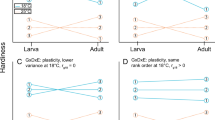Summary
Genotype × temperature interactions for egg laying were studied in Drosophila melanogaster using two sets of half diallel crosses: one between inbred lines of the same geographic origin, and the other between established laboratory, newly derived inbred lines from different geographic origins. The sensitivity of most genotypes to changes in temperature was adequately described as a linear regression of mean in temperature. The regression coefficients (linear sensitivities) were heterogeneous between genotypes. Hybrids were more affected by temperature variation than were inbreds. All the heterogeneity of linear sensitivities was accounted for by a linear function of the genotypic means, which strongly suggests that a scale effect is responsible for the differences in sensitivity to temperature. In contrast, no general relationship was found between standard error deviation (sensitivity to small environmental changes) and mean performance between genotypes, although hybrids tended to be less variable than inbreds. This shows that the sensitivity to environmental variation depends not only on the genotype, but also on the nature of the environmental variation. The variability within temperatures may be affected by the general homeostasis of individual genotypes, while the variability between temperatures could be the result of genes directly affecting the trait and their multiplicative interaction with the environment.
Similar content being viewed by others
References
Ashburner M, Thompson JN Jr (1978) The laboratory culture of Drosophila. In: Ashburner M, Wright TRF (eds) The genetics and biology of Drosophila, vol. 2a. Academic Press, London, pp 1–109
Barlow R (1981) Experimental evidence for interaction between heterosis and environment in animals. Anim Breed Abstr 49:715–737
Clare JM, Luckinbill LS (1985) The effects of gene-environment interaction on the expression of longevity. Heredity 55:19–26
Connolly V, Jinks JL (1975) The genetical architecture of general and specific environmental sensitivity. Heredity 35:249–259
Dobzhansky Th, Levene H (1955) Genetics of natural populations. 24. Developmental homeostasis in natural populations of Drosophila pseudooscura. Genetics 40:797–808
Domínguez A, Albornoz J (1987) Environment-dependent heterosis in Drosophila melanogaster. Génét Sél Evol 19:37–48
Domínguez A, Rubio J (1986) Analysis of genetic factors affecting egg production in Drosophila melanogaster. Heredity 57:305–313
Eberhart SA, Russell WA (1966) Stability parameters for comparing varieties. Crop Sci 6:36–40
Freeman GH, Perkins JM (1971) Environmental and genotypeenvironmental components of variability. 8. Relations between genotypes grown in different environments and measures of these environments. Heredity 27:15–23
Fripp YJ (1972) Genotype-environmental interactions in Schizophyllum commune. 2. Assessing the environment. Heredity 28:223–238
Fripp YJ, Caten CE (1973) Genotype-environmental interactions Schizophyllum commune. 3. The relationship between mean expression and sensitivity to change in environment. Heredity 30:341–349
Lawes DA (1977) Yield improvement in Spring oats. J Agric Sci 89:751–757
Lerner IM (1954) Genetic homeostasis. Oliver and Boyd, Edinburgh
Mather K (1955) The genetical basis of heterosis. Proc R Soc London Ser B 144:143–150
Mather K (1975) Genotype × environment interactions. 2. Some genetical cosiderations. Heredity 35:31–53
Mather K, Caligari PDS (1974) Genotype × environment interactions. 1. Regression of interaction on overall effect of the environment. Heredity 33:43–59
Paroda RS, Hayes JD (1971) An investigation of genotype-environment interactions for rate of ear emergence in spring barley. Heredity 26:157–175
Perkins JM, Jinks JL (1968 a) Environmental and genotypeenvironmental components of variability. 3. Multiple lines and crosses. Heredity 23:339–356
Perkins JM, Jinks JL (1968 b) Environmental and genotypeenvironmental components of variability. 4. Non-linear interactions for multiple inbred lines. Heredity 23:525–535
Powell W, Phillips MS (1984) An investigation of genotype environment interactions in oat lines (Avena sativa) derived from composite populations. Heredity 52:171–178
Robertson FW, Reeve ECR (1952) Homozygosity, environmental variation and heterosis. Nature 170:286
Robertson FW, Reeve ECR (1955) Studies in quantitative inheritance. 8. Further analysis of heterosis in crosses between inbred lines of Drosophila melanogaster. Z Indukt Abstamm Vererbungsl 86:439–458
Ruban PS, Cunningham EP, Sharp PM (1988) Heterosis × nutrition interaction in Drosophila melanogaster. Theor Appl Genet 76:136–142
Sang JH (1964) Nutritional requirements of inbred lines and crosses of Drosophila melanogster. Genet Res 5:50–67
Tachida H, Mukai T (1985) The genetic structure of natural populations of Drosophila melanogaster. 19. Genotype-environment interaction in viability. Genetics 111:43–55
Tantawy AO (1957) Heterosis and genetic variance in hybrids between inbred lines of Drosophila melanogaster in relation to the level of homozygosity. Genetics 42:535–543
Westerman JM (1971) Genotype-environment interaction and developmental regulation in Arabidopsis thaliana. 2. Inbred lines, analysis. Heredity 26:93–106
Westerman JM, Lawrence MJ (1970) Genotype-environment interaction and developmental regulation in Arabidopsis thaliana. 1. Inbred lines; description. Heredity 25:609–627
Author information
Authors and Affiliations
Additional information
Communicated by J. S. F. Barker
Rights and permissions
About this article
Cite this article
Santiago, E., Domínguez, A., Albornoz, J. et al. Environmental sensitivity and heterosis for egg laying in Drosophila melanogaster . Theoret. Appl. Genetics 78, 243–248 (1989). https://doi.org/10.1007/BF00288806
Received:
Accepted:
Issue Date:
DOI: https://doi.org/10.1007/BF00288806




